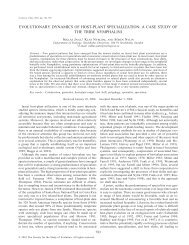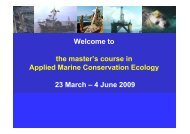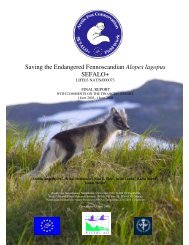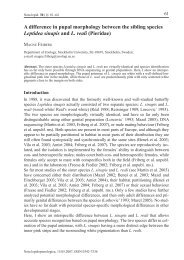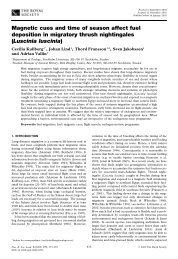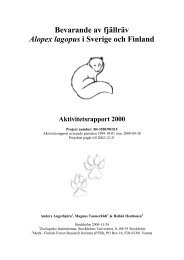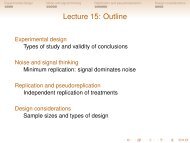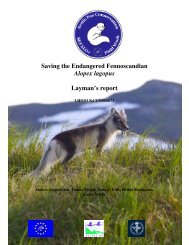and the effect will rather be that <strong>of</strong> fear that such killing could infer. For successful breeding, the <strong>arctic</strong>fox is dependent on specific large dens and studies have shown that <strong>arctic</strong> <strong>foxes</strong> avoid breeding in thevicinity <strong>of</strong> red <strong>foxes</strong> and are accordingly pushed into areas at higher altitudes with lower productivity(Elmhagen et al., 2002). According to data from Finland, where red fox abundance was compared to<strong>arctic</strong> fox abundance (Figure 2.), the red fox had a clear effect on the <strong>arctic</strong> fox dynamics. When thered fox appeared at the traditional <strong>arctic</strong> fox dens in Finland, they first stayed only during the wintersbut after a few years they stayed all year around and also reproduced at these dens. We saw similartrends in the Swedish <strong>arctic</strong> fox areas (Angerbjörn et al., 2002). However, whether the red fox has adirect effect on <strong>arctic</strong> <strong>foxes</strong> through intraguild predation or direct competition is had not yet beeninvestigated. Alternatively the effect shown in the Finnish data set could be due to indirect exploitativecompetition or even a case with no competition at all.Management actions aiming to preserve the <strong>Fennoscandian</strong> <strong>arctic</strong> fox were firstly implemented in theEU/LIFE project SEFALO (1998-2002) by Sweden and Finland and later on in SEFALO+ (2003-2008) by Sweden, Finland and Norway. <strong>The</strong> aims <strong>of</strong> the first phase <strong>of</strong> SEFALO was to halt the presentdeclining population trend and enhance the chances for the species to increase in numbers, bysupplementary feeding and red fox control (Angerbjörn et al., 2002). In the lemming peak year 2001,recruitment to the population was good, especially in the areas where SEFALO had combinedsupplemental feeding with red fox culling. During the second project period, we have used a dynamicmanagement approach to monitor and allocate <strong>conservation</strong> actions to support the species in the mostefficient way. A supplementary feeding programme during both summer and winter has been used inorder to increase reproductive output and juvenile survival and a red fox control programme tosafeguard the best <strong>arctic</strong> fox territories. <strong>The</strong>se actions were implemented within authorities to ensurecontinuation <strong>of</strong> monitoring and <strong>conservation</strong> actions after the proposed project. Supplemental feedinghas earlier been shown to confer an increased cub survival (Tannerfeldt et al., 1994) and an increasednumber <strong>of</strong> litters (Angerbjörn et al., 1991). However, whether supplemental feeding also conveys inan increased litter size has not yet been investigated. Supplementary feeding <strong>of</strong> the <strong>arctic</strong> fox,however, involves a risk <strong>of</strong> attracting red <strong>foxes</strong> to <strong>arctic</strong> fox territories. <strong>The</strong>refore, we consider acombined evaluation <strong>of</strong> both actions necessary since supplementary feeding <strong>of</strong> <strong>arctic</strong> <strong>foxes</strong> involves arisk <strong>of</strong> attracting red <strong>foxes</strong> to <strong>arctic</strong> fox territories. We expect red fox culling to leave more dens andterritories suitable for establishment <strong>of</strong> <strong>arctic</strong> <strong>foxes</strong>, which implies more litters born and higherjuvenile survival due to decreased predation from red <strong>foxes</strong>. Hence, in combination with feeding, weexpect to increase the number <strong>of</strong> successful reproductions. In this report, we aim to evaluate the effect<strong>of</strong> supplemental feeding and red fox culling on the number and size <strong>of</strong> <strong>arctic</strong> fox litters on a local andregional scale. On a local scale, we also aim to separate the effects <strong>of</strong> supplemental feeding from thoseconnected to red fox culling.MATERIAL AND METHODSArctic <strong>foxes</strong> at inhabited dens were fed during winter with commercial dog food (Dogman Dinner), orin some cases remains from reindeer slaughter, by putting out a plastic container within 100 m from anactive den. <strong>The</strong> containers were controlled for <strong>arctic</strong> or red fox activity at least once a month. Red<strong>foxes</strong> have been culled during winter in areas close to recent or previous <strong>arctic</strong> fox territories byrangers in the county administration with special permits for using snowmobiles. All hunting has takenthe utmost caution as not to cause any disturbance to other wildlife. We have classified a territory asbeing hunted if one or several red <strong>foxes</strong> had been shot within 2.3 km from a specific den.To evaluate the effect <strong>of</strong> supplemental feeding and red fox culling on the number and size <strong>of</strong> <strong>arctic</strong> foxlitters on a regional scale, we have used den surveys to investigate presence and breeding success <strong>of</strong>the <strong>arctic</strong> fox in all areas. During the summer inventories, we surveyed all known dens inHelagsfjällen (SE), Borgafjäll (SE), Børgefjell (NO), Vindelfjällen (SE) and parts <strong>of</strong> Norrbotten (SE)for <strong>arctic</strong> fox activity between years 2001-2007. Management actions in Helagsfjällen (SE) andBorgafjäll (SE) have been intense and continual during the entire study period, whereas actions havebeen moderate in Vindelfjällen (SE) and Norrbotten (SE) (Table1). In Børgefjell (NO), no actionshave been implemented. <strong>The</strong>se areas differ in size, in number <strong>of</strong> natal dens (defined as having at least4
one <strong>arctic</strong> fox reproduction between 1981-2007 and number <strong>of</strong> reproducing <strong>arctic</strong> <strong>foxes</strong> (Table 1).However, since the areas are situated in discrete mountain areas and all <strong>of</strong> them contain high-quality<strong>arctic</strong> fox habitats, we consider that they have similar prerequisites for <strong>arctic</strong> fox activity and are thusvalid for comparison. <strong>The</strong>re are additional <strong>arctic</strong> fox habitats on the Finnish and Norwegian mountaintundra as well but there are no records <strong>of</strong> <strong>arctic</strong> fox presence in Finland since 1994 and in Norway, nomanagement actions have been implemented. Thus, we consider a comparison with these areasuninformative.Presence <strong>of</strong> <strong>arctic</strong> or red fox at dens has been determined by visual observation or DNA analysis <strong>of</strong>faeces collected during surveys. A den was considered as inhabited when <strong>arctic</strong> fox presence wasdocumented by visual observations or faecal DNA analysis. When rodent abundance is increasing orhigh, most adult <strong>arctic</strong> <strong>foxes</strong> try to reproduce and are stationary at dens during summer. A den surveyduring a year <strong>of</strong> high or increasing rodent abundance will thus provide a good approximate <strong>of</strong> thenumber <strong>of</strong> adult <strong>arctic</strong> <strong>foxes</strong>. However, during a year with low food availability, fewer individuals tryto reproduce and will therefore not be stationary at the dens which conveys in difficulties toapproximate the number <strong>of</strong> individuals. Since visual observations during summer are mainly restrictedto stationary and breeding adults, and the detection probability will thus be affected by the local rodentdensity. Tannerfeldt & Angerbjörn (1998) suggested that <strong>arctic</strong> fox reproduction mainly occurredduring years with high rodent availability. Generally, both the male and the female participate in cubrearing and, during this period, they are rather stationary (Angerbjörn et al., 2004). <strong>The</strong>refore, duringyears with low rodent density, there is a risk to underestimating the number <strong>of</strong> individuals alive due tothe low number <strong>of</strong> breeding adults. When rodent density is low, it is likely that there is a highernumber <strong>of</strong> non-breeding adults that are not tied permanently to specific dens. We have thereforefocused on the years <strong>of</strong> increasing rodent densities in some <strong>of</strong> our analyses (i.e. 2001, 2004 and 2007).Visual or audible observations <strong>of</strong> <strong>arctic</strong> fox cubs were used for recording presence <strong>of</strong> litters. <strong>The</strong>minimum litter size at weaning was determined by direct counts <strong>of</strong> the number <strong>of</strong> cubs observed at theden.To evaluate the joint and separate effect <strong>of</strong> red fox culling and supplemental feeding, we studied theeffect <strong>of</strong> supplemental feeding and red fox culling on the number and size <strong>of</strong> <strong>arctic</strong> fox litters inHelagsfjällen in Jämtland county (SE) between 2001-2007. Here, we aimed to investigate the jointand separate effect <strong>of</strong> supplemental feeding and red fox culling in relation to specific territorieswithout any actions at all (Table 2). As can be seen in Table 2, the number <strong>of</strong> territories displayed tomanagement actions differed between years.Of the 25 natal dens in the Helags area, we supplied 20 with extra food for one or several years (alltogether n=82) (Table 2). <strong>The</strong> <strong>arctic</strong> <strong>foxes</strong> used these feeding stations in varying extent where at someplaces up to 20 kg <strong>of</strong> dog food could be consumed during 30 days but in other cases only a few kg wasused. However, in the following analyses, we have only included data on whatever a den was fedduring the winter or not. Furthermore, we have used data provided by the county board administrationon red fox culling. Red <strong>foxes</strong> have been culled during the winters in areas close to recent or previous<strong>arctic</strong> fox territories by rangers in the county administration with special permits. All hunting hastaken the utmost caution as not to cause any disturbance to other wildlife. In total, 245 red <strong>foxes</strong> havebeen shot in the area over all years (Table 1). In these analyses, we classified a territory as beinghunted if one or several red <strong>foxes</strong> had been shot within 2.3 km from a specific den. A characteristic<strong>arctic</strong> fox territory is approximately 25 km 2 (Angerbjörn, Stroman & Becker, 1997), which gives aradius <strong>of</strong> 2.3 km around the den. In some territories more than one red fox was shot, however, we havein our statistical analyses only classified territories as being hunted or not hunted.5



